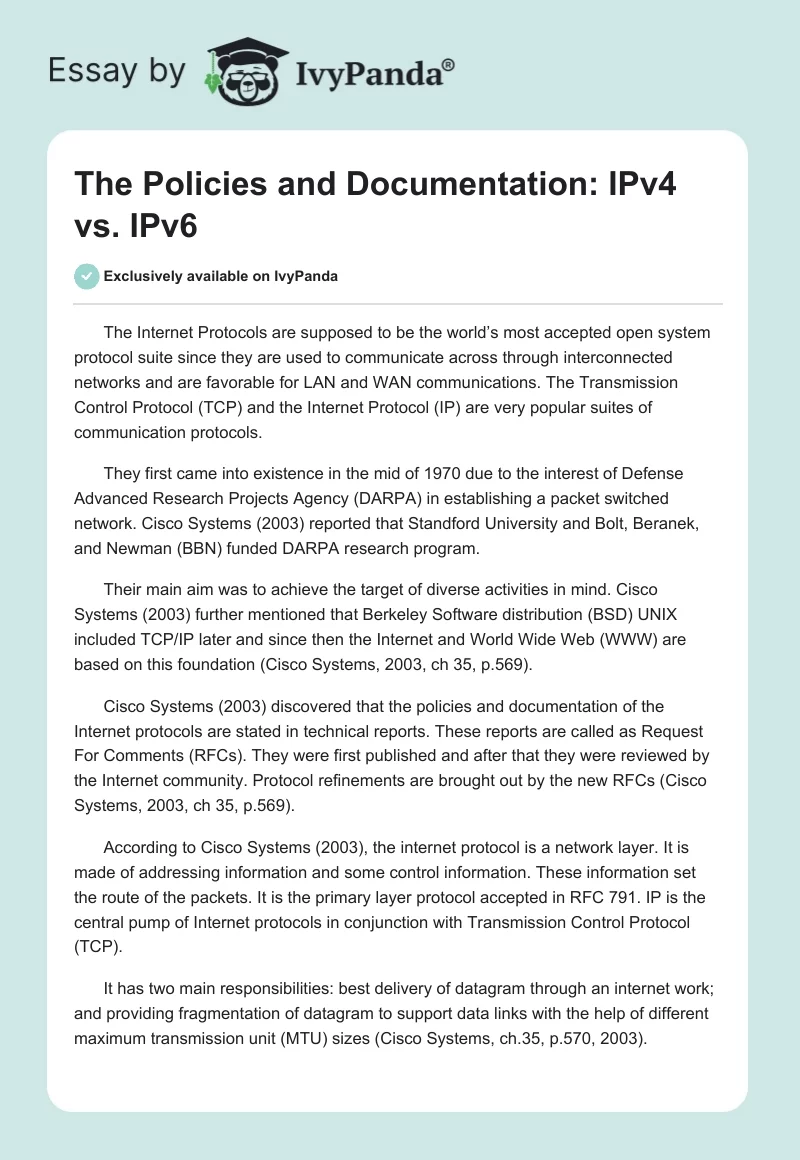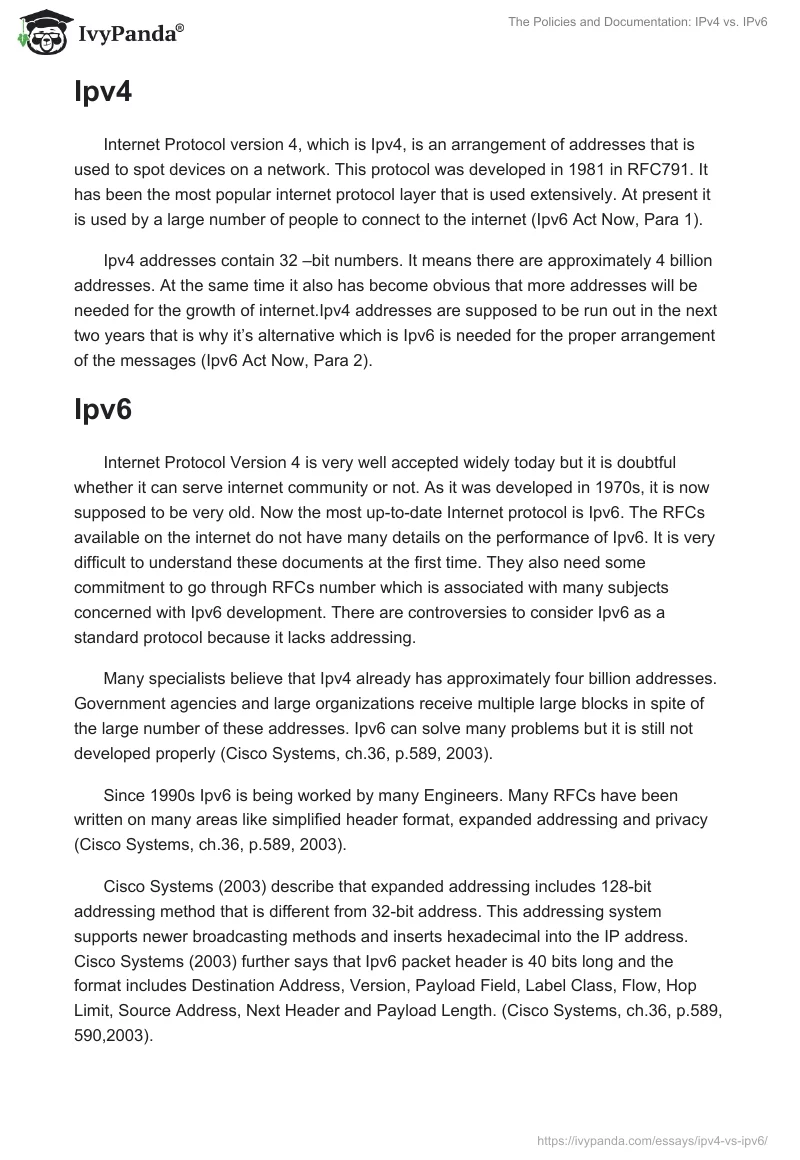The Internet Protocols are supposed to be the world’s most accepted open system protocol suite since they are used to communicate across through interconnected networks and are favorable for LAN and WAN communications. The Transmission Control Protocol (TCP) and the Internet Protocol (IP) are very popular suites of communication protocols.
They first came into existence in the mid of 1970 due to the interest of Defense Advanced Research Projects Agency (DARPA) in establishing a packet switched network. Cisco Systems (2003) reported that Standford University and Bolt, Beranek, and Newman (BBN) funded DARPA research program.
Their main aim was to achieve the target of diverse activities in mind. Cisco Systems (2003) further mentioned that Berkeley Software distribution (BSD) UNIX included TCP/IP later and since then the Internet and World Wide Web (WWW) are based on this foundation (Cisco Systems, 2003, ch 35, p.569).
Cisco Systems (2003) discovered that the policies and documentation of the Internet protocols are stated in technical reports. These reports are called as Request For Comments (RFCs). They were first published and after that they were reviewed by the Internet community. Protocol refinements are brought out by the new RFCs (Cisco Systems, 2003, ch 35, p.569).
According to Cisco Systems (2003), the internet protocol is a network layer. It is made of addressing information and some control information. These information set the route of the packets. It is the primary layer protocol accepted in RFC 791. IP is the central pump of Internet protocols in conjunction with Transmission Control Protocol (TCP).
It has two main responsibilities: best delivery of datagram through an internet work; and providing fragmentation of datagram to support data links with the help of different maximum transmission unit (MTU) sizes (Cisco Systems, ch.35, p.570, 2003).
Ipv4
Internet Protocol version 4, which is Ipv4, is an arrangement of addresses that is used to spot devices on a network. This protocol was developed in 1981 in RFC791. It has been the most popular internet protocol layer that is used extensively. At present it is used by a large number of people to connect to the internet (Ipv6 Act Now, Para 1).
Ipv4 addresses contain 32 –bit numbers. It means there are approximately 4 billion addresses. At the same time it also has become obvious that more addresses will be needed for the growth of internet.Ipv4 addresses are supposed to be run out in the next two years that is why it’s alternative which is Ipv6 is needed for the proper arrangement of the messages (Ipv6 Act Now, Para 2).
Ipv6
Internet Protocol Version 4 is very well accepted widely today but it is doubtful whether it can serve internet community or not. As it was developed in 1970s, it is now supposed to be very old. Now the most up-to-date Internet protocol is Ipv6. The RFCs available on the internet do not have many details on the performance of Ipv6. It is very difficult to understand these documents at the first time. They also need some commitment to go through RFCs number which is associated with many subjects concerned with Ipv6 development. There are controversies to consider Ipv6 as a standard protocol because it lacks addressing.
Many specialists believe that Ipv4 already has approximately four billion addresses. Government agencies and large organizations receive multiple large blocks in spite of the large number of these addresses. Ipv6 can solve many problems but it is still not developed properly (Cisco Systems, ch.36, p.589, 2003).
Since 1990s Ipv6 is being worked by many Engineers. Many RFCs have been written on many areas like simplified header format, expanded addressing and privacy (Cisco Systems, ch.36, p.589, 2003).
Cisco Systems (2003) describe that expanded addressing includes 128-bit addressing method that is different from 32-bit address. This addressing system supports newer broadcasting methods and inserts hexadecimal into the IP address. Cisco Systems (2003) further says that Ipv6 packet header is 40 bits long and the format includes Destination Address, Version, Payload Field, Label Class, Flow, Hop Limit, Source Address, Next Header and Payload Length. (Cisco Systems, ch.36, p.589, 590,2003).
Though Ipv4 is easily implemented, interoperable and robust and has been tested on scaling an internet work, yet this initial design did not expect the following things (Introduction to Ipv6, 2005, Para 1):
- The growth of internet and the imminent exhaustion of the Ipv4 address space: Ipv4 addresses have become very limited. In Introduction to Ipv6 (2005, Para 2) it is mentioned that some of the organizations unwillingly make use of a network address translator for arranging multiple private addresses which happen on a single public IP address. NATs support recycling of the private address space but they do not favor standards-based network layer. Two organizations can face problems while being connected and using the private address space. Now it is being assumed that growing importance of internet connected devices can diminish the public Ipv4 address space (Introduction to Ipv6, 2005, Para 2).
- According to Introduction to Ipv6 (para3, 2005), the ability of internet backbone routers for maintaining large routing tables: The present Ipv4 internet routing infrastructure takes account of both flat and hierarchical routing. (Introduction to Ipv6, 2005, Para 3).
- Simpler Configuration requirement: Introduction to Ipv6 (Para 4, 2005) focuses on the recent Ipv4 implementations and mentions that they should be either manually or through a stateful address configuration protocol like Dynamic Host Configuration Protocol (DHCP). Since more computers and devices use IP, easier and more automatic configuration of addresses is necessary. There is a need of such kind of arrangement which do not depend on the management of a DHCP infrastructure (Introduction to Ipv6, 2005, Para 4).
- IP level needs security at some levels: The internet is the public means for private communication. It needs encryption services which protect the data sent from viewed during transmission (Introduction to Ipv6, 2005, Para 5).
- Better support for real time delivery of data is also required: In Introduction to Ipv6 (Para 6, 2005) it is mentioned that Ipv4 has some standards for quality of service (QoS) where real time traffic support depends on the Ipv4 Type of Service (TOS) field and the identification of the payload. It further says that it has been observed that the role of TOS in Ipv4 is very not as much as necessary rather it has different explanations. (Introduction to Ipv6, 2005, Para 6).
In Introduction to Ipv6 (Para 7, 2005) it is mentioned that the Internet Engineering Task Force (IETF) is concerned with the limitations of Ipv4 as mentioned above so it has developed a suite of protocols and standards which is popular as IP Version 6 (Ipv6).
It further tells that Ipv6 was previously named as IP-The next Generation (Ipng). It gives attention to updating the Ipv4 protocol by including many proposed methods. It is globally planned to give less effect on upper and lower layer protocols by not following the illogical addition of new features (Introduction to Ipv6, 2005, Para 7).
Ipv6 has some innovative broadcasting methods as follows:
- Unicast: It is a communication amid a single host and receiver. Packets which are sent to a Unicast address are delivered to the interface that is known to the address (Cisco Systems, 2003, ch.36, p.591). Sadao Yamaguchi (2003) discover that it was not at all clear in Ipv4 either a network interface or a node has been assigned an address but Ipv6 explicitly describes that an address is put together on each network interface. Sadao Yamaguchi (2003) states that Ipv6 unicast address can be separated by scopes: Global scope is for worldly communication; site scope is for site and link scope is for local link. It has uses within a router boundary (Sadao Yamaguchi, 2003, Para 5 & 6).
- Multicast: Sadao Yamaguchi (2003) affirms that multicast is built up for a multicast group. A particular multicast group can trace multiple nodes and then the group can be given out a multicast address. Sadao Yamaguchi (2003) further mentions that the multicast addresses will be precised through the broadcasting nodes and then it will send packets to all nodes in the multicast group. Scopes like global, organization-local, site-local, node-local and link-local can be associated with this feature (Sadao Yamaguchi, 2003, Para 1, 2 & 6). The Ipv4 has small space for address though in Ipv6 multicast can be conducted more freely (Sadao Yamaguchi, 2003, Para 1, 2 & 6).
- Anycast: Sadao Yamaguchi (2003) describes that Anycast address is newly introduced in Ipv6. It has some specific functions. Nodes and interface are not distributed to it. It sends packet to the adjacent node in the group. Its activity is just opposite to the function of multicast. A specific address range is not distributed here. To a certain extent it is given unicast address range. It has three scopes which are similar to unicast address but its use is no very clear. (Sadao Yamaguchi, 2003, Para 1, 2 & 3).
Ipv4 vs. Ipv6
There are many variations between Internet Protocol Version 4 and Internet Protocol Version 6 however the main difference is in the length of address (Amit Vartak, 2007). For finding out differences between these two versions of internet protocol, we will first analyze the characteristics of Ipv4 and then we will examine the characteristics of Ipv6 (Ipv4 vs. Ipv6: Guides and Tutorials, 2008).
Characteristics of Ipv4
- Its addresses are as long as 32 bits.
- Ipsec support is discretionary in Ipv4.
- A checksum is found in header.
- Its header is not well-known to the packet flow.
- Here routers and sending host both divide packets
- Header has some choices to be made.
- Internet Group Management Protocol supervises local subnet groups’ membership.
- Address Resolution Protocol makes use of broadcast frames to determine an IP address.
- Broadcast addresses manage the traffic to all nodes.
- For deciding the Ipv4 address, ICMP router discovery is used.
- It must be built up either by manually or by DHCP.
- It uses host address (A) resource records in Domain Name System for Ipv4 addresses’ host name
- Ipv4 vs. Ipv6: Guides and Tutorials (2008) discover that Ipv4 uses pointer resource records I the IN-ADDR ARPA DNS domain for Ipv4 addresses to host names.
Characteristics of Ipv6
- Its addresses are as long as 128 bits.
- Its header has a field called Flow Label that recognizes packet flow.
- Here sending host fragments packets and routers do not fragment packets.
- Checksum are not found in its header.
- Ipv6 extension headers contain all optional data.
- The resolution of IP addresses depend upon Multicast Neighbor Solicitation messages.
- Multicast Listener Discovery takes charge of the local subnet groups.
- For deciding the Ipv4 address, ICMPv6 Router Solicitation and Router Advertisement Messages are used. They are not discretionary.
- It uses a link local scope.
- It does not need manual configuration or DHCP.
- It uses host address (AAA) resource records in Domain Name System for Ipv6 addresses’ host names.
- Ipv4 vs. Ipv6: Guides and Tutorials (2008) discover that Ipv6 uses pointer resource records in the IP6 ARPA DNS domain for Ipv4 addresses to host names.
Conclusion
The population of the world is compelling to switch from Ipv4 to Ipv6. It’s all happening due to the growth in population. It is assumed that in future almost all the vehicles will be networked to use Onstar or other navigational devices and that time IP’s will be required. Looking at these situations we need more exclusive IP’s than we have at present (Ipv4 vs. Ipv6- ipv6 the future, 2005, Para 4).
References
Cisco Systems (2003) Internetworking technologies handbook (p.1078), Edition: 4, Cisco Press. Web.
Introduction to IPv6 (2005), Microsoft TechNet. Web.
IPv4 vs. IPv6: Guides and Tutorials (2008), TechArena Community. Web.
IPv4 vs. IPv6- IPv6 the future (2005). Web.
Vartak, Amit (2007) IPv4 vs. IPv6, Security Beta. Web.
What is Ipv4? Ipv4 Act Now. Web.
Yamaguchi, Sadao (2003), Unicast, Multicast and Anycast, Ipv6style. Web.


